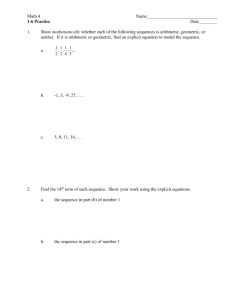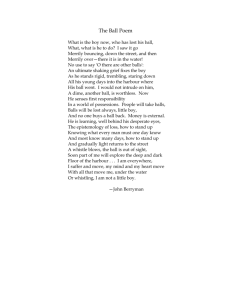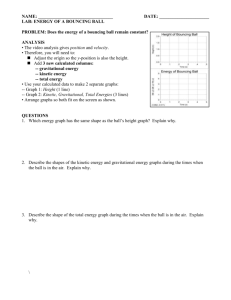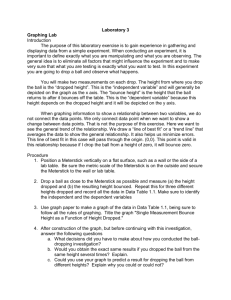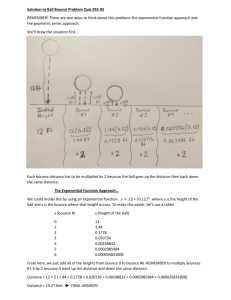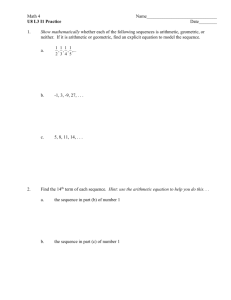Balls and Graphs
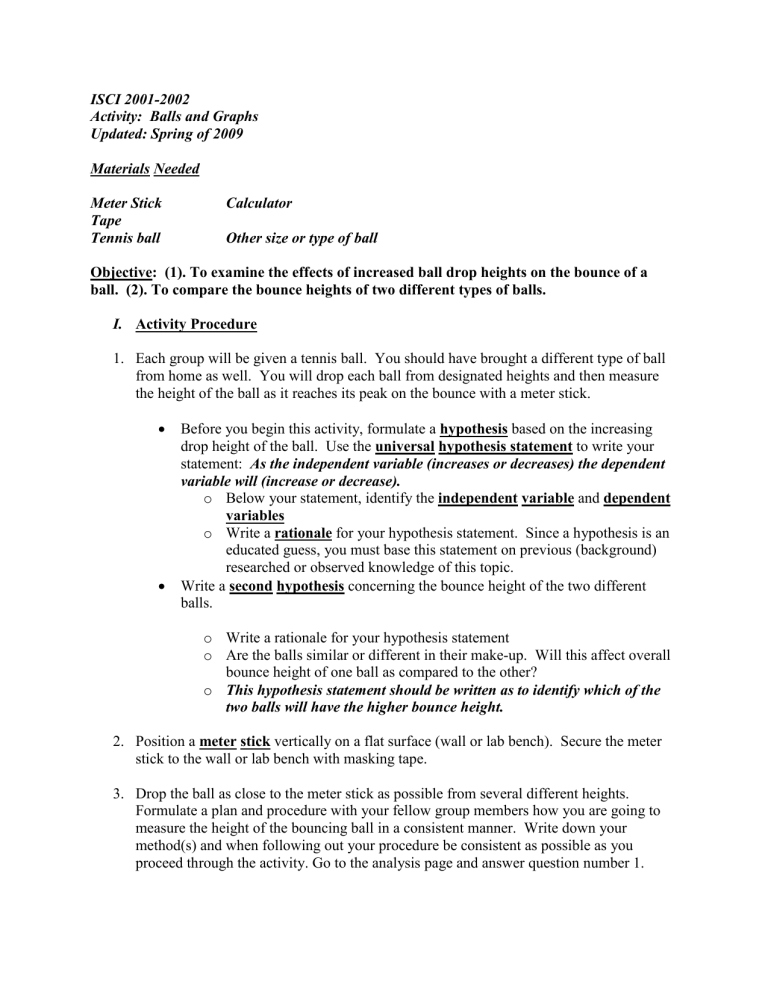
ISCI 2001-2002
Activity: Balls and Graphs
Updated: Spring of 2009
Materials Needed
Meter Stick
Tape
Tennis ball
Calculator
Other size or type of ball
Objective: (1). To examine the effects of increased ball drop heights on the bounce of a ball. (2). To compare the bounce heights of two different types of balls.
I.
Activity Procedure
1.
Each group will be given a tennis ball. You should have brought a different type of ball from home as well. You will drop each ball from designated heights and then measure the height of the ball as it reaches its peak on the bounce with a meter stick.
Before you begin this activity, formulate a hypothesis based on the increasing drop height of the ball. Use the universal hypothesis statement to write your statement: As the independent variable (increases or decreases) the dependent variable will (increase or decrease).
o Below your statement, identify the independent variable and dependent variables o Write a rationale for your hypothesis statement. Since a hypothesis is an
Write a second hypothesis concerning the bounce height of the two different balls. educated guess, you must base this statement on previous (background) researched or observed knowledge of this topic. o Write a rationale for your hypothesis statement o Are the balls similar or different in their make-up. Will this affect overall bounce height of one ball as compared to the other? o This hypothesis statement should be written as to identify which of the two balls will have the higher bounce height.
2.
Position a meter stick vertically on a flat surface (wall or lab bench). Secure the meter stick to the wall or lab bench with masking tape.
3.
Drop the ball as close to the meter stick as possible from several different heights.
Formulate a plan and procedure with your fellow group members how you are going to measure the height of the bouncing ball in a consistent manner. Write down your method(s) and when following out your procedure be consistent as possible as you proceed through the activity. Go to the analysis page and answer question number 1.
4.
Go to the data collection page and find out what heights you will drop the ball from. Be sure to complete three trials for each height dropped. Record your data in table (1).
Produce a proper title for the table. The title should be a direct reflection on the type of data you have collected. Be sure to list the surface you dropped the ball on (tile floor, carpet, etc.) Calculate the averages for each height dropped.
5.
Repeat the procedure followed in step 4 , but in this trial use the alternate ball. Record your data in table (2).
Be sure to drop the balls on the same surface. Give your table a title. Record the type of ball used in this part of the activity.
6.
Obtain a piece of graph paper. Each member of the group should do their own graph.
Refer to the example given to you during the discussion of proper graphing. Graph your results from tables (1 and 2). Graph only the averaged data for each height . You will need to use a different coloring system, different pens, line-types, for each set of data .
Make sure you provide a key or legend.
Produce a line-graph for this data
7.
Next, take a ruler and draw a line through the data points . If the data points are continuous (data is either increasing or decreasing at a constant rate), it should come out as a straight line. If your data is scattered, draw a line of best fit (refer to your example graph).
8.
Calculate the ‘ slope’ of the line for each set of data. The formula for the slope of the line is:
Slope = Y
2
– Y
1
/ X
2
– X
1
Record the slope for each surface in table 3 .
9.
Take another sheet of graph paper, and graph the slopes (averages) of the the bounce height of the two types of balls.
Make a bar graph to show this data. Be sure to distinguish between the two sets of data by color coding, etc. Make sure the axes are correctly labeled. Provide a key or legend.
*Please Note: Data tables must be reproduced. I will accept the original data tables only if they are (1) neat and (2). Cut and pasted on the report page. I will not accept the instructional pages attached to the report.
II.
Data Collection
Table 1: ___________________________________ Ball Type: ____________
Height
Dropped(cm)
Height Bounced
(cm) Trial 1
Height Bounced
(cm) Trial 2
Height Bounced
(cm) Trial 3
30
Average
Bounce
Height(cm)
60
90
Table 2: ______________________________ Ball Type: ___________________
Height
Dropped(cm)
Height Bounced
(cm) Trial 1
Height Bounced
(cm) Trial 1
Height Bounced
(cm) Trial 1
Average
Bounce
Height(cm)
30
60
90
Table 3: ____________________________
Ball Type Average Slope (cm)
III.
Questions and Analysis
(1).With your partner, briefly discuss the criteria you decided on as to determining the height of the bounced ball for each trial. Why is it important to be consistent during a scientific investigation?
(2). Hypothesis Statements:
Hypothesis Statement 1 : _______________________________________________________
Rationale:
Hypothesis Statement 2: ________________________________________________________
Rationale:
(3). Concerning your first hypothesis, what did the data tell you about bounce height
(dependent) vs height dropped (independent)? Use data to back up your statements.
Use your first line graph to help you with your analysis statements.
(4). Concerning hypothesis statement number 2, what did the data tell you about the bounce height of the different types of balls? Use data to back up your statements.
Use your bar graph (comparison of slopes) to help you write your analysis statements.
(5).In a couple of paragraphs, summarize the result(s) of the activity below. Be sure to use the data from your graphs to support your statements. Be clear, concise and brief.
Discuss trends in the data. Were the variables directly related, indirectly related, why or why not. Can you come to a solid conclusion based on the data collected? Was there enough data to support or reject your hypothesis?
Activity Report
1.
Title
2.
Objective
3.
Hypothesis with variables identified
4.
Data Collection
All tables, charts, etc
5.
Graph (s) and Analysis
6.
Analysis Questions and Answers (complete and attach questions)

